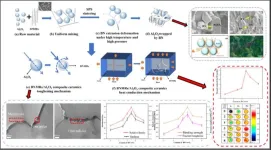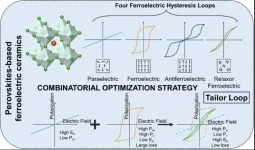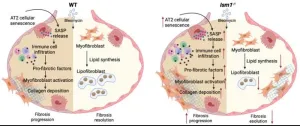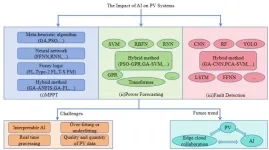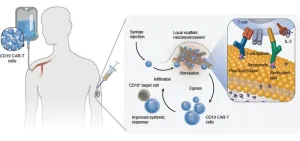(Press-News.org) Many modern bridges use orthotropic steel bridge decks (OSBD), the decks being the surface sections of the bridge. OSBDs were designed to be lightweight and economical. However, this design has shown increasing issues with pavement cracking and fatigue damage at the welds that connect the bridge deck to the bridge superstructure. Fatigue damage is damage that accrues over time with use.
To ameliorate these problems, a new bridge deck was designed. The composite bridge deck system (CBD) added a layer of concrete to decrease the probability of damage due to fatigue. More recently the use of high-performance materials, such as ultra-high-performance concrete (UHPC) and engineering cementitious composites (ECC), have been incorporated into the CBD design.
Chinese scientists recently reviewed current research on the performance and durability of these two types of bridge deck designs and the effect of incorporating the new high-performance materials into the design of the newer CBD.
“Both new and traditional bridge deck systems possess distinct advantages and disadvantages, indicating their suitability for various application scenarios. A comprehensive review of these bridge deck systems can provide scholars and engineers with a deeper understanding and facilitate their effective application” said Jingzhong Tong, a researcher at the Institute of Advanced Engineering Structures.
Their review was published on April 29 in Intelligent Construction.
The researchers reviewed studies on the traditional orthotropic steel bridge deck systems, along with the newer composite bridge deck system which used one of three different materials: the original steel- concrete, and two high-performance materials, steel- UHPC and steel-ECC. UHPC and ECC are cementitious composites with properties that are very useful in bridges.
UHPC has ultra-high compressive strength allowing for the use of thinner slabs with greater bending strength and greater stiffness than regular concrete. It is therefore easier to build with and does a better job under stress. ECC is very tough and highly resistant to cracking.
The studies they reviewed used different measures of bridge deck fitness. Examples of the types of measurements used in the papers included a bridge deck’s flexural behaviour, which is how the materials and design of the bridge deck react to loads that may cause bending, the fatigue behavior of critical welds on the bridge deck and the durability of the pavements, among many other factors.
The review found that fatigue performance was the greatest issue in the OSBD, and that the CBD design had comparatively greater fatigue resistance and sectional stiffness, which would be useful in long span bridges. When the UHPC was used in the CBD design instead of the steel-concrete, it increased the bridge decks’ flexural performance. ECC use improved the bridge decks’ crack resistance.
“The integration of these advanced cementitious composites into bridge deck systems significantly enhances their mechanical properties and durability, thereby mitigating the high maintenance costs associated with repetitive damage,” said Yunlong Chen, the paper’s first author and a scientist at Zhejiang University.
Overall, on looking at the research that they had reviewed the scientists felt that “for critical infrastructure where frequent maintenance is impractical, the implementation of new bridge decks utilizing cementitious composites is highly recommended due to their superior durability,” said Qinghua Li, a researcher at Zhejiang University. The cementitious composites are more expensive initially, but with the increased durability of the resulting bridge decks and their lower maintenance costs over the life span of the bridge, this would result in a lower cost in the longer term.
When asked what comes next Chen said “the next step is to reduce the cost of cementitious composites, thereby expanding their range of applications. Subsequently, the design method for the new bridge deck system utilizing cementitious composites could be validated through more practical engineering applications. The ultimate goal is to develop an ideal bridge deck that achieves affordability, long service life, lightweight construction, and convenience in installation.”
Other Contributors include Shilang Xu from the Institute of Advanced Engineering Structures, Zhejiang University, Hangzhou, China and Luming Shen of the School of Civil Engineering, The University of Sydney, New South Wales, Australia.
This study was funded by Zhejiang Provincial Natural Science Foundation of China, the National Natural Science Foundation of China, and the ZJU-USyd Ignition Grants.
About Journal of Intelligent Construction
Journal of Intelligent Construction (JIC), sponsored by Tsinghua University and the China National Committee on Large Dams, published by Tsinghua University Press (TUP) and exclusively available via SciOpen, is a peer-reviewed journal for publishing original research papers, case studies, reviews and comments regarding the use of novel technologies in all domains of civil engineering, e.g., hydraulic engineering, structural engineering, geotechnical engineering, transportation, and construction management. The journal focuses on the application of advanced theories, methodologies, and tools, such as machine learning, sensors, robotics, 5G, the Internet of Things, artificial intelligence, building information modelling, and computational methods, etc., in all stages of the construction life cycle, which makes the process more intelligent and efficient. The journal also covers other essential areas of civil engineering, e.g., planning and design, operation and maintenance, and disaster mitigation.
About SciOpen
SciOpen is a professional open access resource for discovery of scientific and technical content published by the Tsinghua University Press and its publishing partners, providing the scholarly publishing community with innovative technology and market-leading capabilities. SciOpen provides end-to-end services across manuscript submission, peer review, content hosting, analytics, and identity management and expert advice to ensure each journal’s development by offering a range of options across all functions as Journal Layout, Production Services, Editorial Services, Marketing and Promotions, Online Functionality, etc. By digitalizing the publishing process, SciOpen widens the reach, deepens the impact, and accelerates the exchange of ideas.
END
In recent years, the high complexity of integrated devices has made heat accumulation increasingly critical and has resulted in higher heat dissipation requirements for substrates and packaging materials. In this study, boron nitride microribbon (BNMR)/Al2O3 composite ceramics are prepared using spark plasma sintering (SPS). This study examines the effect of varying the amount of toughened phase BNMR on the density, mechanical properties, dielectric constant, and thermal conductivity of BNMR/Al2O3 composite ceramics while also exploring the mechanisms behind the toughening and increased ...
With the escalating impacts of climate change and depletion of resources, dielectric capacitors are emerging as promising high-demanded candidates for high-performance energy storage devices. However, due to the shortcomings of various dielectric ceramics (e.g., paraelectrics, ferroelectrics, and antiferroelectrics), their low polarizability, low breakdown strength, and large hysteresis loss limit their standalone use in the advancing of energy storage ceramics. Therefore, synthesizing novel perovskite-based materials that exhibit high energy density, high energy efficiency, and low loss is crucial in achieving superior energy ...
Idiopathic pulmonary fibrosis (IPF) is a chronic and progressive lung disease marked by the thickening and scarring of lung tissue with unclear etiology. Affecting around five million people worldwide, IPF causes severe respiratory problems and greatly diminishes the quality of life. Despite ongoing medical research, the exact cause of IPF is still unknown, and treatment options are limited. The prognosis for IPF is grim, with only about 20% of patients surviving five years post-diagnosis, highlighting the critical need for better therapies and a deeper understanding ...
Thermoelectric technology, which enables the direct conversion of heat into electricity, has emerged as a promising alternative energy source. Notably, this technology can efficiently convert body heat into electrical energy, garnering significant attention in the field of wearable electronics. However, the dense structure of most thermoelectric materials results in ultra-low moisture permeability. In practical applications, insufficient moisture permeability can trap heat and humidity, fostering bacterial growth and potentially causing skin lesions. Hence, developing thermoelectric materials with superior moisture permeability is crucial.
A team led by ...
Artificial intelligence is poised to bring photovoltaic systems into a new era through revolutionary improvements in efficiency, reliability, and predictability of solar power generation.
In their paper published on May 8 in CAAI Artificial Intelligence Research, a research team from Chinese and Malaysian universities explored the impact of artificial intelligence (AI) technology on photovoltaic (PV) power generation systems and their applications from a global perspective.
“The overall message is an optimistic outlook on how AI can lead to more sustainable and efficient energy solutions,” said Xiaoyun Tian from ...
PHILADELPHIA – Syphilis cases are on the rise around the globe, but many Americans don’t know the symptoms.
In January, the Centers for Disease Control and Prevention (CDC) reported that syphilis cases had risen 80 percent over the five years from 2018 to 2022, totaling more than 200,000 in 2022, the last year for which data are available.
Yet just over half of U.S. adults (54%) know that a case of syphilis can be permanently cured and most either mistakenly think there is a vaccine to prevent it (16%) or are unsure (45%), according to the Annenberg Public Policy ...
The Norwegian Academy of Science and Letters today announced the 2024 Kavli Prize Laureates in the fields of astrophysics, nanoscience, and neuroscience. The 2024 Kavli Prize in Neuroscience honors McGovern Investigator and MIT neuroscientist Nancy Kanwisher, UC Berkeley neurobiologist Doris Tsao, and Rockefeller University neuroscientist Winrich Freiwald for their discovery of a highly localized and specialized system for representation of faces in human and non-human primate neocortex. The neuroscience laureates ...
Eight scientists from three countries are honored for their research that has broadened our understanding of the big, the small and the complex.
June 12, 2024 (Oslo, Norway) — The Norwegian Academy of Science and Letters today announced the 2024 Kavli Prize Laureates in the fields of astrophysics, nanoscience and neuroscience. Eight scientists from three countries are honored for their research that has broadened our understanding of the big, the small and the complex. The laureates in each field will share $1 million USD.
The ...
Washington, D.C—The nasal microbiota of intensive care unit (ICU) patients effectively distinguishes sepsis from non-septic cases and outperforms analyzing the gut microbiota to predict sepsis, according to a new study published in Microbiology Spectrum, a journal of the American Society for Microbiology.
“These findings have implications for the development of diagnostic strategies and advancements in critical care medicine,” said corresponding study author Xiaolong He, M.D., Ph.D., a professor at the Microbiome Medicine Center, Department of Laboratory Medicine, ...
T-cell stimulating biomaterial that slowly biodegrades under the skin stimulates CAR-T cells in the body to improve therapeutic efficacy in an aggressive mouse tumor model.
By Benjamin Boettner
(BOSTON) — CAR-T cell therapies are transforming the treatment of previously incurable blood cancers. Six approved CAR-T products have been administered to more than 20,000 people, and more than 500 clinical trials are underway. However, according to a recent study out of the Massachusetts General Hospital, ...
